White Peaks, Bluebird Skies, Flapping Wingbeats
 As graduate students spending a year at the North Cascades Environmental Learning Center, winter is a contemplative and focused time – a time of respite from teaching Mountain School programs to work on group projects for our nonprofit and curriculum classes. This work, along with an in-depth research project on a Natural History topic of our choosing, comprises the bulk of our academic studies.
As graduate students spending a year at the North Cascades Environmental Learning Center, winter is a contemplative and focused time – a time of respite from teaching Mountain School programs to work on group projects for our nonprofit and curriculum classes. This work, along with an in-depth research project on a Natural History topic of our choosing, comprises the bulk of our academic studies.
This kind of project-based learning allows for us to structure our studies around time spend outside naturalizing and exploring the winter world of the Cascades. A canoe paddle on Diablo Lake breaks up hours of writing and research while giving us a chance to feel inspired by icicles clinging to rocky cliff ledges near Thunder Knob. A hike up to Buster Brown Field allows us to the breath in the deep, crisp air while listening for golden-crowned kinglets that have just returned from their winter migrations. Feeling reenergized, we are able to focus again on the work at hand.
As much as we cherish these opportunities to explore the natural world just outside our doorsteps, sometimes we need time away in different places altogether where new adventures, learning, and inspiration can occur. Cohort 11 recently returned from just such an adventure: A three-day Winter Graduate Retreat at Mount Rainier National Park and the Skagit Flats.
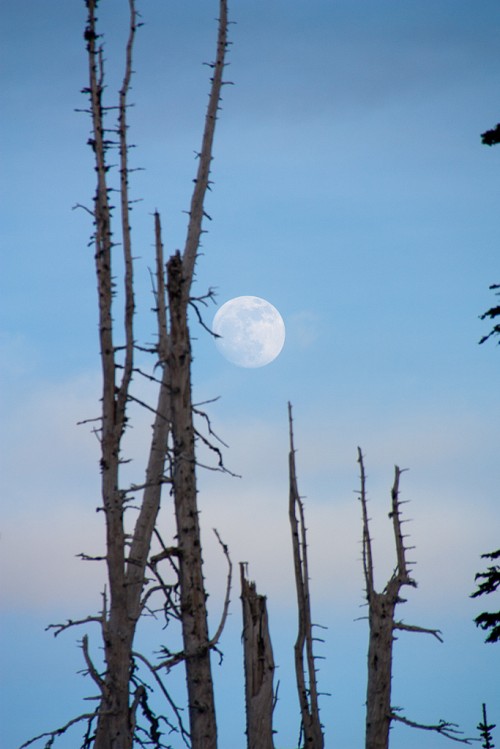
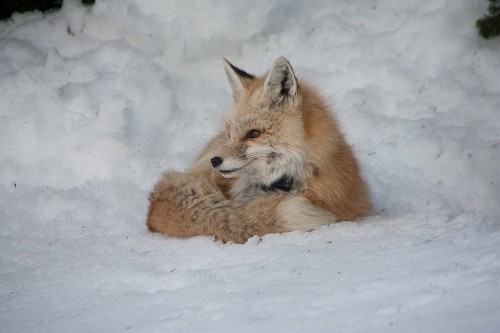 A red fox curled up in the snow. Above, the moon rising in an alpine glow sky at Mount Rainier. Photo by Jess Newley.
A red fox curled up in the snow. Above, the moon rising in an alpine glow sky at Mount Rainier. Photo by Jess Newley.
We began the retreat with bluebird skies and a four-hour car ride that landed us at the base of Mount Rainier. Many of us were so eager to begin our adventure at the Park that we drove straight up to Paradise Meadows on the southwest face of the mountain at 5,400 ft. After orienting ourselves to the winter ecology, glaciology, and geologic history of the Park at the Visitor’s Center, graduate students dispersed to explore this singular volcano in the Cascades Range. In just a few short minutes of hiking around, a number of us turned to see a red fox sauntering along the trail beside us. We gasped, looking around in wonder as a second fox, this one a silver morph of the first, came quietly behind it. Both had their noses to the ground, and neither seemed to be paying us, or their proximity to the parking lot of Paradise, any mind. These habituated foxes were simply out for a dusk perusal of their territory and feeding grounds. Having never seen a fox at such close distance myself, I was delighted. We watched them for a time, following their trails into the trees. Looking up, we spotted a porcupine in a subalpine fir above our heads munching on needle buds and dropping pellets onto the snow. An hour at the Park and already the wildlife count was up! Our first day ended with a stunning sunset and alpine glow across the wintery beauty of Mount Rainier.
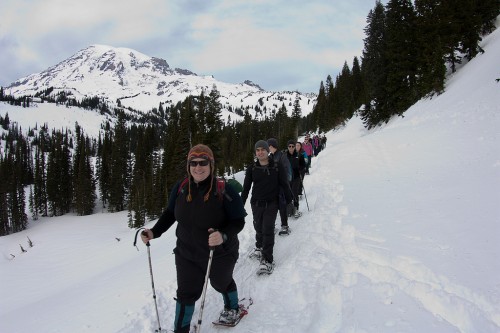
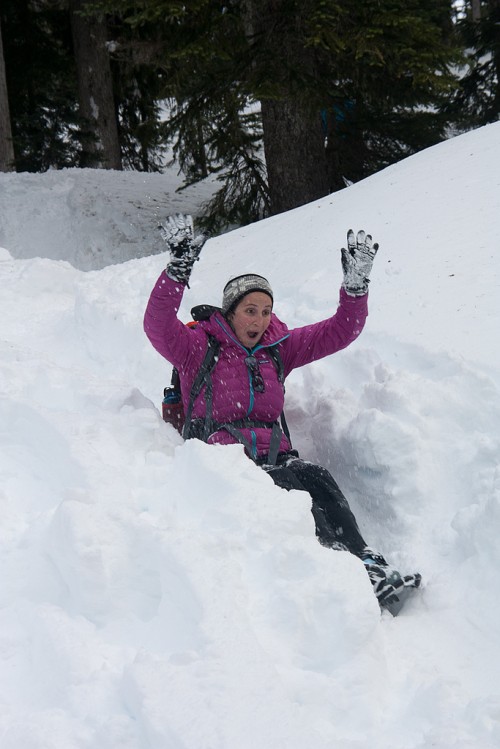 Winter snowshoeing, tracking, and fun at Mount Rainier! Photos by Jess Newley.
Winter snowshoeing, tracking, and fun at Mount Rainier! Photos by Jess Newley.
Day two took us back up to Paradise, this time to spend the day on snowshoes with three great trackers from the Wilderness Awareness School. The group quickly found fox tracks from our encounters the day before, and our guides used the opportunity to teach us the basic art of tracking as we learned to assess gait pattern, size, shape, and impression. The day flew by as we began deciphering meaning in the snow – weasel tracks, squirrel signs, canine scent markings, and plenty of evidence of the red foxes. When we weren’t looking down at the snow for signs, our guides showed us how to interpret clues in the larger habitat around us – bear rubs and peelings on firs, the dotted horizontal lines made by sapsuckers as they feed on the cambium layer beneath tree bark. Naturalizing and tracking in this new landscape allowed many graduate students to “poke around” with fresh eyes, and we all felt grateful for such an opportunity.
The end of the day found us back near the Paradise Visitor’s Center wandering in search of additional fox sign. Sure enough, and as if on cue, we found one of our furry friends curled up beneath a subalpine fir the way canines are so apt to do. This little creature again paid us no mind as we chattered away about its cuteness, and we discovered that if we made just the right amount of noise the fox would lift its head and stare straight into our eyes. After finally leaving the inhabitant to its own devices, we watched another evening of alpine glow transform the mountains.

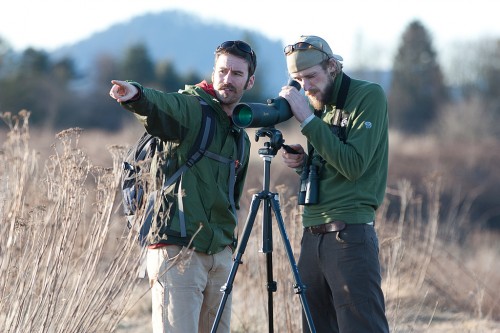 Grads engaged in the world of migratory birds on the lower Skagit Flats. Photos by Jess Newley.
Grads engaged in the world of migratory birds on the lower Skagit Flats. Photos by Jess Newley.
On the third and final day of our Winter Graduate Retreat, we said goodbye to Mount Rainier and headed back towards the Environmental Learning Center, stopping along the way in the lower Skagit Flats for an afternoon of winter birding with North Cascades Institute staff member, Amy Brown. Amy took us to some of her favorite local birding sites, including Wylie Slough, Fir Island Road, and Jensen’s Access at the mouth of the Skagit Delta. The Skagit Flats, a manipulated delta of dikes and raised farmlands, is prime winter-feeding habitat for many migratory bird species. Throughout the afternoon, we spotted pintails, coots, song sparrows, trumpeter swans, bald eagles, harriers, hawks, short-eared owls, and merlins. But the highlight for many of us was the flock of over 10,000 snow geese feeding in a field of green. As we stood watching the sea of white, two juvenile bald eagles began diving at the flock and agitating them into flight. We stood transfixed in wonder at the glory of such a sight as the entire masse of geese flew up and over our heads – the thunderous sound and beauty of so many wingbeats flapping in unison. It felt for a moment as if we were flying among them. Our time studying the phenomenon of bird migrations with Amy was an incredibly rewarding experience, and one that many graduate students will cherish.
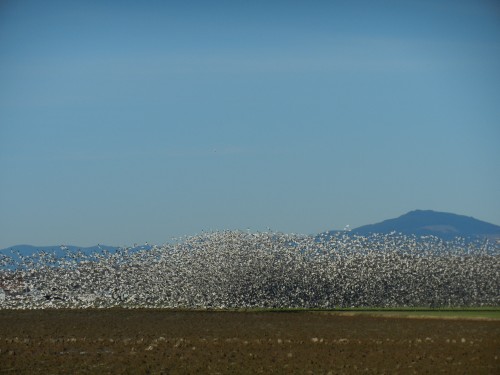
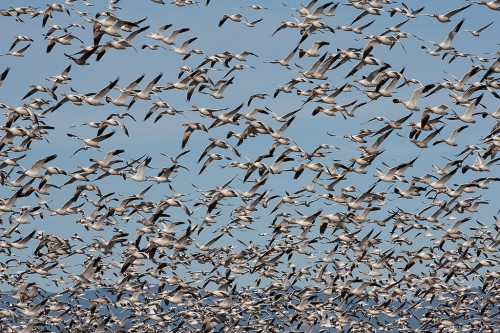 Thousands of snow geese thunder in flight over our heads. Photos by Jess Newley and Kiira Heymann.
Thousands of snow geese thunder in flight over our heads. Photos by Jess Newley and Kiira Heymann.
At the end of the day we headed back to the mountains, ready to dig into books and projects once more. We returned feeling inspired and invigorated by the weekend, and with a sense that our appreciation and understanding of the natural world had been broadened by such an adventure.


Wow. ! What a great adventure. I had no idea the wily fox would let you get so close. I appreciate too that as read your adventure it was like being there with you. The pictures helped with that of course. I have always marveled that so many birds could be in the air at once and not run into each other or seemingly even touch.
It is such a joy for me to read what you are doing and the maturity of your writing far surpasses my great expectations. Anyone wanting to know what graduate school is like would get a good picture with this blog.
Awesome! So many wildlife sightings! 🙂
Wonderful post, Chris! And what a glorious weekend was had by all. I’m so glad that only a few of us got pooped on by the snow geese!
Looks like you got a good taste of the best Washington State has to offer in the winter, especially with the birds and wildlife. Thanks for sharing the adventure with us!